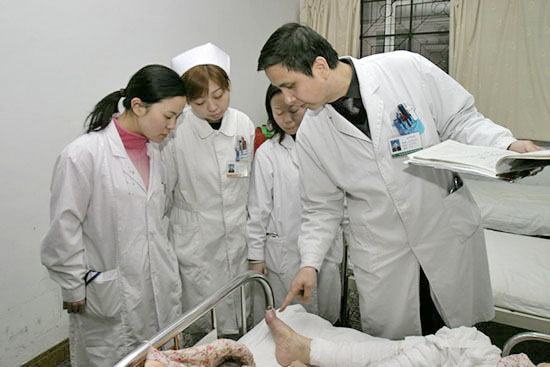
The Endocrinology Department of the fourth hospital of Hebei Medical University is a professional department with the characteristics of diagnosis and treatment of endocrine and metabolic diseases. There are 2 wards in the headquarters and the East Hospital, with 3 chief doctors and professors, 5 deputy chief doctors and associate professors, 6 attending doctors and 5 doctors. Among them, there are 8 doctors, 11 masters and 3 talents. The general practitioners are united and cooperative, and their business is superb. In diabetes and its complications, thyroid disease, adrenal disease, pituitary disease, abnormal lipid metabolism, obesity, gout, osteoporosis and tumor endocrine treatment, etc. In 2005, we took the lead in developing the new technology of "autologous peripheral blood stem cell transplantation for the treatment of diabetic foot", which has relieved the suffering of dozens of diabetic foot patients, published more than 20 related papers, and won 2 Science and technology progress awards. In 2007, we took the lead in the interventional treatment of diabetic lower extremity angiopathy (diabetic foot) and arteriography, balloon dilatation and stent implantation of lower extremity. More than 800 cases have been completed, reducing the amputation rate of diabetic foot patients from 34% to 4%. The 8th "new progress in diagnosis and treatment of diabetic foot and special symposium on interventional treatment of diabetic lower extremity angiopathy" was held. The ointment for diabetic foot was developed by ourselves. For many patients with diabetic foot saved feet, saved lives. In 2010, cord stem cell transplantation was carried out. In 2018, led the establishment of the professional committee of diabetic foot of Hebei society of integrated traditional Chinese and Western medicine, held a number of academic activities to promote the interventional treatment technology of diabetic foot in the whole province. In 2019, the information management of blood glucose was carried out, making the Endocrinology Department of our hospital in the leading position in the diagnosis and treatment of diabetes and diabetic foot. Thyroid nodule ablation was also carried out. One phase-2 clinical trial and five phase-3 clinical trials have been completed, including three international multi center clinical trials. He has compiled 6 professional works.
Our hospital has an advanced endocrine metabolism detection system, which can detect thyroid hormone, pituitary hormone, sex hormone, urinary microalbumin, adrenocortical hormone, insulin, C-peptide, venous blood glucose, fast blood glucose, etc. at any time. The results were accurate, reliable and convenient. Our department has advanced diabetic foot diagnosis box, lower extremity artery disease, neuropathy and percutaneous oxygen partial pressure detection system, which provides an objective, reliable and non-invasive detection method for the early diagnosis of diabetic foot. It provides convenience for early prevention and treatment of diabetic foot. The circulatory driven therapy instrument provides a noninvasive and non drug therapy for diabetic patients with lower extremity vascular disease. The application of insulin pump and dynamic blood glucose makes the blood glucose control faster and more stable. In addition, the Department also has ECG, blood pressure, respiration, blood oxygen monitor and rapid blood glucose meter, injection pump, infusion pump, ECG machine and other equipment, which provides more effective examination and treatment means for critical patients.
Main diagnosis and treatment scope
1、Diabetes mellitus and its complications: diabetic ketoacidosis, diabetic hyperglycemia and hyperosmotic state, diabetic nephropathy, diabetic cardiomyopathy, diabetic neuropathy, vascular disease, diabetic ophthalmopathy, diabetes mellitus with infection, etc.
Diabetic foot intervention and stem cell transplantation: numbness, weakness, intermittent claudication, rest pain, foot infection, ulcer, gangrene, etc.
2、Thyroid diseases: hyperthyroidism, hypothyroidism, thyroiditis, thyroid nodules, etc.
3、Adrenal diseases: corticosteronism, primary aldosteronism, pheochromocytoma, adrenal hypofunction
4、Hypothalamic pituitary disease, acromegaly, diabetes insipidus, hypophysis and so on.
5、Dyslipidemia, obesity, gout, osteoporosis and various unexplained hypertension.